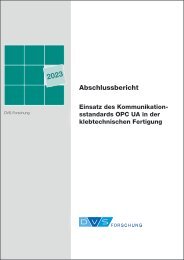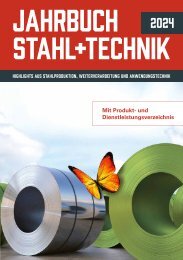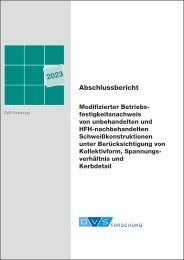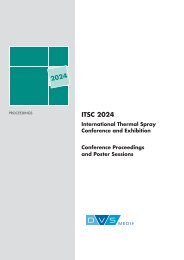Sie wollen auch ein ePaper? Erhöhen Sie die Reichweite Ihrer Titel.
YUMPU macht aus Druck-PDFs automatisch weboptimierte ePaper, die Google liebt.
2.2.1 Delay laws<br />
In what follows, formulas for beam steering are given for a one-dimensional linear array of<br />
identical and regularly spaced rectangular elements. This is the simplest case mathematically, and<br />
will be sufficient to illustrate basic phased array principles. There will be different formulae that<br />
determine beam steering characteristics for more complex phased array probe geometries, such as<br />
irregularly spaced linear elements, annular arrays and two-dimensional arrays, but these are<br />
beyond the scope of this Handbook.<br />
Delay laws determine the focal characteristics and steering behavior of the ultrasonic beam. Angle<br />
beam steering is accomplished by applying a linear time delay function to the individual elements.<br />
For unfocused beams, the angle of sound in the material is directly proportional to the applied time<br />
delay; as the applied time delay increases, so does the angle. The formula governing this behavior<br />
is shown in Equation 2-1, where θ = requested angle of incidence, n = 0, 1, 2, ... – number of<br />
array elements with respect to the central array element, с = sound velocity in material, t 0 = a<br />
constant value for avoiding negative delay values, and d = distance between the centre of two side<br />
by side elements.<br />
t<br />
d<br />
n sin <br />
Equation 2-1<br />
c<br />
n t o<br />
When using this equation, the central array element time delay is calculated by using n = 0 in the<br />
equation, which in this case is t n = t 0 . The time delay of the element directly on one side is the<br />
central element is then calculated by setting n = 1, and the element directly on the other side by<br />
n = –1. By varying the value of n over all of the elements in the virtual aperture, the time delays of<br />
all of the elements are derived.<br />
Focusing is accomplished by applying a delay function; various functions such as parabolic<br />
function can be used for this purpose. The focal depth is inversely proportional to the applied time<br />
delay; therefore, as the maximum applied time delay decreases, the focal depth increases. The<br />
formula governing this behavior is shown in Equation 2-2 for a focussed ultrasonic beam<br />
propagating at = 0 into material, where F = requested focal depth, and the other variables are<br />
defined above.<br />
t<br />
n<br />
2<br />
F nd 2<br />
1<br />
1<br />
1/ <br />
to<br />
Equation 2-2<br />
c F <br />
Equation 2-3 is the equation governing the creation a focused angle beam by combining angle<br />
beam steering and focusing simultaneously, and reduces to the first two equations for simpler<br />
cases. If Equation 2-3 is considered in the limit F (i.e. in the limit of an unfocussed ultrasonic<br />
sound beam), then the result is Equation 2-1. If Equation 2-3 is considered in the limit of <br />
(i.e. normal incident sound), then the result is Equation 2-2. Lastly, if Equation 2-3 is considered<br />
in the limit of n = 0 only (i.e. only one element in the phased array probe), then t n = t 0 , or the time<br />
delay is arbitrary, as is expected with conventional ultrasonic testing with single crystal probes.<br />
Note that Equations 2-1, 2-2 and 2-3 apply only when the phased array probe is directly coupled to<br />
the test material with normal incidence, and do not take into consideration a wedge attached to the<br />
probe. Equation 2-3 and Figure 2-4 are the sum of equations 2.1 and 2.2.<br />
2<br />
F nd nd 2<br />
t 1/<br />
n 1 1 2 sin <br />
t o<br />
Equation 2-3<br />
c F F<br />
5


















